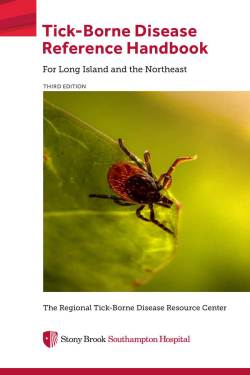TICK REMOVAL KIT
Our Tick Removal Kit contains all you need to be prepared for tick bites—pointy tweezers, magnifier, first-aid supplies, and Tick ID Card—all packaged in a kit you can hang on your backpack or put in your pocket.
To Inquire About a Tick Removal Kit:
Email: karen.wulffraat@stonybrookmedicine.edu with the subject line: Tick Kit Request and provide your mailing address or call (631) 726-TICK.
Download PDF Version of Tick ID Card (English)
Download PDF Version of Tarjetas de Identificación de Garrapatas (Espanol)
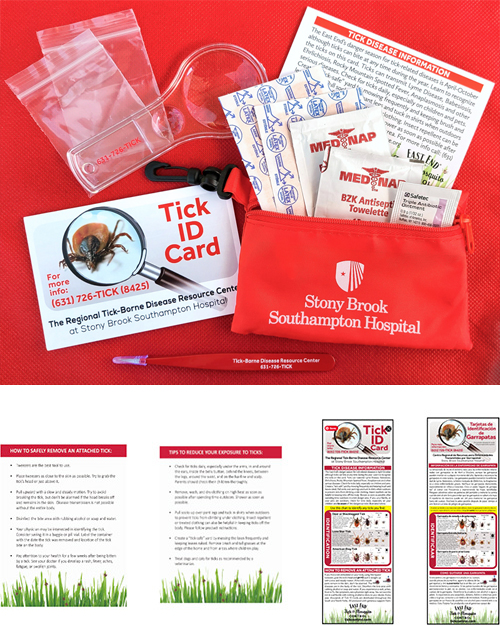
HOW TO SAFELY REMOVE AN ATTACHED TICK
- Tweezers are the best tool to use.
- Place tweezers as close to the skin as possible. Try to grab the tick’s head or just above it.
- Pull upward with a slow and steady motion. Try to avoid breaking the tick, but don’t be alarmed if the head breaks off and remains in the skin. Disease transmission is not possible without the entire body.
- Disinfect the bite area with rubbing alcohol or soap and water.
- Your physician may be interested in identifying the tick. Consider saving it in a baggy or pill vial. Label the container with the date the tick was removed and location of the tick bite on the body.
- Pay attention to your health for a few weeks after being bitten by a tick. Se your doctor if you develop a rash, fever, aches, fatigue, or swollen joints.
TIPS TO REDUCE YOUR EXPOSURE TO TICKS
- Check for ticks daily, especially under the arms, in and around the ears, inside the belly button, behind the knees, between the legs around the waist, and on the hairline and scalp. Parents should check their children thoroughly.
- Remove, wash, and dry clothing on high heat as soon as possible after spending time outdoors. Shower as soon as possible.
- Pull socks up over pant legs and tuck in shirts when outdoors to prevent ticks from climbing under clothing. Insect repellent or treated clothing can also be helpful in keeping ticks off the body. Please follow product instructions.
- Create a “tick-safe” yard by mowing the lawn frequently and keeping leaves raked. Remove brush and tall grasses at the edge of the home and from areas where children play.
- Treat dogs and cats for ticks as recommended by a veterinarian.
Tick Reference Table
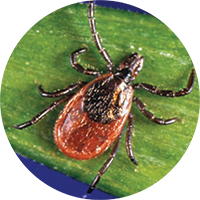
| Pathogen | Infection Type | Disease |
|---|---|---|
| Borrelia burgdorferi | Bacteria | Lyme disease |
| Anaplasma phagocytophilum | Bacteria | Anaplasmosis |
| Borrelia miyamotoi | Bacteria | Borrelia miyamotoi disease |
| Babesia microti | Protozoan Parasite | Babesiosis |
| Powassan virus | Virus | Powassan virus disease |
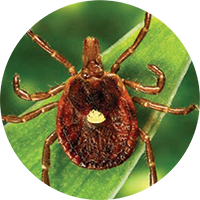
| Pathogen | Infection Type | Disease |
|---|---|---|
| Ehrlichia chaffeensis / Ehrlichia ewingii | Bacteria | Ehrlichiosis |
| Francisella tularensis | Bacteria | Tularemia |
| Heartland virus | Virus | Heartland virus disease |
| Bourbon virus | Virus | Bourbon virus disease |
| Unknown | Unknown | Southern tick-associated rash illness (STARI) |
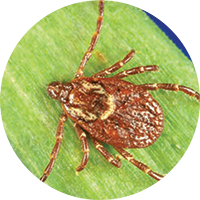
| Pathogen | Infection Type | Disease |
|---|---|---|
| Francisella tularensis | Bacteria | Tularemia |
| Rickettsia rickettsii | Bacteria | Rocky Mountain spotted fever |
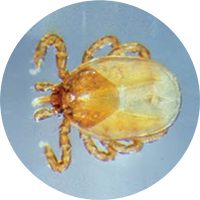
| Pathogen | Type of Infection | Disease |
| Powassan virus | Virus | Powassan virus disease |


